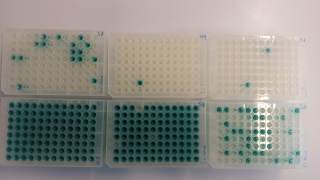One barrier to routine water quality testing is the time and cost required to collect samples in the field, transport them to a laboratory, conduct an analysis, and produce and use the results. WHO and UNICEF have been working to make field testing more easy, quick, and affordable, by using portable testing kits. WHO has supported a laboratory evaluation of commercially available portable testing kits, while UNICEF is working with manufacturers to support the development of innovative kits that produce actionable results in much shorter time frames.

Laboratory assessments
In 2019, WHO in consultation with a Technical Advisory Group developed a protocol for evaluation of portable test kits, which specified approaches to be followed for quantitative tests, semi-quantitative tests, and qualitative tests. After a competitive bidding process, the KWR Research Institute in the Netherlands was selected to conduct assessments on 20 portable kits, all of which relied on incubation of samples in growth media. The kits can be grouped into those that quantify results by counting colonies, and those that measure growth in suspension, usually but not always through a Most Probable Number statistical method.
Colony counting tests
Most of the quantitative portable kits assessed used colony counting methods. The majority used membrane filtration and 100 mL samples, but two products were assessed with 1 mL samples without filtration. One portable kit used an innovative gel medium, to allow counting of colonies without using membrane filtration.
- Compact Dry EC plates (1 mL)
- Compact Dry ECO plates (1 mL)
- Compact Dry ECO plates with membrane filtration (100 mL)
- 3M Petrifilm SEC plates with membrane filtration (100 mL)
- Sartorius Chromocult Nutrient Pads with membrane filtration (100 mL)
- Delagua kit with membrane filtration and lauryl sulfate broth (100 mL)
- Trace2o AquaSafe WSL20 kit with membrane filtration and lauryl sulfate broth (100 mL)
- Hach MEL kit with membrane filtration and m-ColiBlue24 medium (100 mL)
- Trace2o WaterScope with membrane filtration (100 mL)
- Aquagenx gel EC CFU bag (100 mL)
Suspension tests
Some kits use proprietary wells or compartments to divide a sample into multiple sub-samples, and produce a Most Probable Number (MPN) using standard statistical methods. One kit (Fluidion ALERT LAB) used optical data to measure changes in absorbance and fluorescence over time, and calculate a contamination level. The other suspension kits assessed used 10 or 100 mL volumes to indicate the presence or absence of E. coli. In order to produce quantitative results from these presence-absence tests, where possible 100 mL sample volumes were divided up into 96 volumes of approximately 1 mL each, using deep well plates (see photo above). After incubation, the number of positive wells was used to produce an MPN statistic.
- HiMedia HiSelective (100 mL)
- EC Blue (100 mL)
- AquaChrom ECC (100 mL)
- Hach Pathoscreen (100 mL)
- Resorufin (100 mL)
- IDEXX MPN tubes (10 mL)
- ECC MPN (100 mL)
- Aquagenx Compartment Bag Test EC+TC MPN (100 mL)
- Palintest Colitag MPN (100 mL)
- Fluidion ALERT LAB (40 mL)
Rapid water quality testing project
UNICEF, in collaboration with WHO, has developed a Rapid Water Quality Testing project to catalyse the continuous improvement of existing portable water quality testing products, and the development of innovative new products which might allow more efficient, accurate, or low-cost testing of drinking water quality in the field. The project has produced a Target Product Profile (TPP) to describe the desired characteristics of a field test kit. The TPP, first published in September 2016, was updated in December 2019 and again in November 2022.
In May 2022 two new approaches to rapid water quality testing were taken to rural Abuja, Nigeria by UNICEF and the Federal Ministry of Water Resources. The week-long field work took place in a number of communities testing boreholes, river water and the Abuja Water Utility treatment facility. One of the kits used (still in prototype) provides Total Coliform and E. coli results within one hour, the other gives a general biological value readout in fifteen minutes. The field testing provided useful inputs to the developers around the ease of use and application in low resource settings, including the reality of field use.
UNICEF and WHO will continue to work with developers and industry actors to build a framework for evaluating these products. One contribution to this has been a partnership with AOAC International to develop a Performance Tested Method assessment protocol for innovative products, which are not based on incubation and colony counting or Most Probable Number analyses, and can't be assessed in the same was as laboratory assessment conducted by WHO.